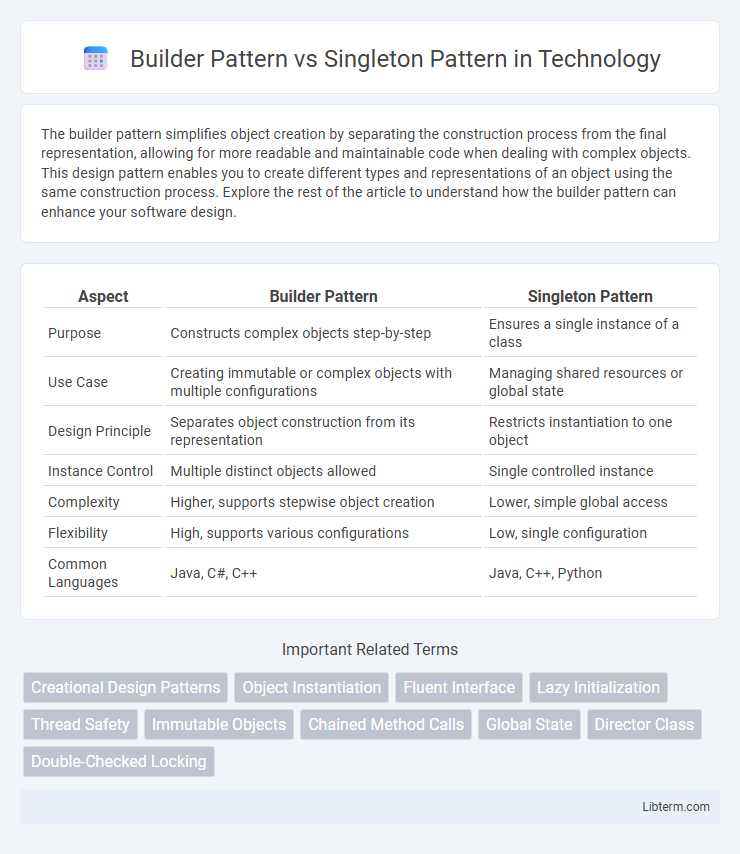The builder pattern simplifies object creation by separating the construction process from the final representation, allowing for more readable and maintainable code when dealing with complex objects. This design pattern enables you to create different types and representations of an object using the same construction process. Explore the rest of the article to understand how the builder pattern can enhance your software design.
Table of Comparison
| Aspect | Builder Pattern | Singleton Pattern |
|---|---|---|
| Purpose | Constructs complex objects step-by-step | Ensures a single instance of a class |
| Use Case | Creating immutable or complex objects with multiple configurations | Managing shared resources or global state |
| Design Principle | Separates object construction from its representation | Restricts instantiation to one object |
| Instance Control | Multiple distinct objects allowed | Single controlled instance |
| Complexity | Higher, supports stepwise object creation | Lower, simple global access |
| Flexibility | High, supports various configurations | Low, single configuration |
| Common Languages | Java, C#, C++ | Java, C++, Python |
Introduction to Design Patterns
Design patterns provide reusable solutions to common software design problems, enhancing code maintainability and scalability. The Builder Pattern separates complex object construction from its representation, allowing step-by-step customization and improving flexibility in object creation. The Singleton Pattern restricts a class to a single instance, ensuring controlled access to shared resources and consistent state management across an application.
What is the Builder Pattern?
The Builder Pattern is a creational design pattern that separates the construction of a complex object from its representation, allowing the same construction process to create different representations. It provides a step-by-step approach to assembling objects, enabling more control over the construction process and improving code readability and maintainability. This pattern is especially useful when creating objects with multiple configurable parameters or when the construction process involves several steps.
What is the Singleton Pattern?
The Singleton Pattern is a design pattern that restricts the instantiation of a class to a single object, ensuring controlled access to that sole instance. It is commonly used in scenarios requiring a global point of access, such as managing configuration settings or logging mechanisms. This pattern ensures thread safety and prevents multiple instances, which helps maintain consistent state throughout the application.
Key Differences Between Builder and Singleton Patterns
The Builder pattern focuses on constructing complex objects step-by-step, allowing different representations of the object, while the Singleton pattern ensures a class has only one instance throughout the application lifecycle. Builder separates object construction from its representation, providing flexibility in object creation, whereas Singleton controls instance creation to prevent multiple instances and often uses lazy initialization. Key differences include Builder's emphasis on object configuration and variation versus Singleton's concern with global access and instance uniqueness.
When to Use the Builder Pattern
The Builder Pattern is ideal for constructing complex objects with multiple optional parameters or configurations, enabling a step-by-step creation process that improves readability and maintainability. It is most effective when an object requires numerous fields with varying combinations or when constructing immutable objects that need to enforce consistency and validation before instantiation. Unlike the Singleton Pattern, which restricts a class to a single instance, the Builder Pattern focuses on flexible object creation and is used when different representations of a product must be created systematically.
When to Use the Singleton Pattern
The Singleton Pattern is ideal when a single, shared instance of a class is required to coordinate actions across a system, such as managing database connections or configuration settings. It ensures controlled access to resources by preventing multiple instantiations, maintaining global state consistency throughout an application. Use the Singleton Pattern when system-wide resource management and single-instance enforcement are critical for application stability and performance.
Advantages of Builder Pattern
The Builder Pattern offers enhanced flexibility by separating the construction of complex objects from their representation, enabling step-by-step customization without affecting the final product's structure. It simplifies the creation of immutable and complex objects with multiple optional parameters, reducing the risk of constructor overloading and improving code readability. This pattern promotes maintainability by isolating construction logic, facilitating easier modifications and testing compared to the Singleton Pattern, which focuses solely on instance control without addressing object complexity.
Advantages of Singleton Pattern
The Singleton Pattern ensures a single instance of a class throughout an application, promoting controlled access to shared resources and consistent state management. It reduces memory overhead by preventing multiple object creations, which is crucial in resource-constrained environments. This pattern simplifies global configuration management, enhancing maintainability and debugging by centralizing instance control.
Real-World Examples: Builder vs Singleton
The Builder Pattern is ideal for constructing complex objects step-by-step, exemplified by configuring customizable user interfaces or assembling multipart documents in software development. The Singleton Pattern ensures a single instance of a class, commonly used in database connection pools or logging frameworks to maintain a consistent global state. Real-world applications demonstrate Builder excels in scenarios requiring flexible object creation, while Singleton enforces resource control and centralized management.
Choosing the Right Pattern for Your Project
Choosing the right pattern for your project depends on the specific design goals: the Builder Pattern is ideal for constructing complex objects step-by-step and ensuring clear separation of construction and representation, while the Singleton Pattern is best suited for scenarios requiring a single, globally accessible instance to manage shared resources. Consider using the Builder Pattern when dealing with immutable objects or when the construction process involves multiple configurations, and opt for the Singleton Pattern when you need controlled access to a unique instance like configuration settings or logging services. Evaluate factors such as object complexity, thread safety, and lifecycle management to determine which pattern aligns with your project's requirements.
Builder Pattern Infographic

 libterm.com
libterm.com